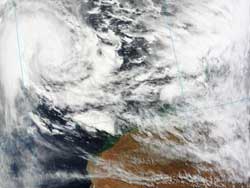Now a cyclone, NASA sees Lua closer to a landfall in northern Australia

On March 15, 2012, at 02:31 UTC, the MODIS instrument onboard NASA's Aqua satellite captured this visible image of Cyclone Lua when it was about 400 nautical miles northwest of Port Hedland, Australia. Lua strengthened into a Cyclone today. Credit: Credit: NASA Goddard MODIS Rapid Response Team<br>
On March 15, 2012 at 02:31 UTC, the Moderate Resolution Imaging Spectroradiometer (MODIS) instrument onboard NASA's Aqua satellite captured a visible image of Cyclone Lua when it was about 400 nautical miles northwest of Port Hedland, Australia. In the image, the bulk of clouds and showers appear to be over the northern and western quadrants of the storm. Satellite imagery shows that Cyclone Lua is consolidating and has tightly-curved bands of thunderstorms wrapping into its center.
A Cyclone warning is now in effect for coastal areas from Bidyadanga to Mardie, including Port Hedland, Karratha and Dampier. A Cyclone Watch has been posted for coastal areas from Cape Leveque to Bidyadanga including Broome, and the eastern inland Pilbara including Newman and Telfer. The Australian Bureau of Meteorology is issuing updates every three hours. To see the updates, visit: http://www.bom.gov.au/cyclone/.
Bloomberg Business reports the Chevron Corporation is evacuating workers along Australia's northwest coast from gas projects and are moving iron ore ships out to sea. Fox Business noted today, March 15, that Port Hedland has begun evacuating personnel and is preparing to shut down as Lua heads toward the Pilbara coast.
On March 15, 2012 at 0900 UTC (5 a.m. EST) Tropical cyclone Lua's maximum sustained winds had increased to 65 knots (75 mph/120 kph). It was centered near 15.7 South latitude and 113.0 East longitude, about 435 miles northwest of Port Hedland, Australia. It is generating very rough seas as it moves slowly toward the coast.
Cyclone Lua was moving to the west at 5 knots (5.7 mph/9.2 kph) and is expected to move toward the southeast in the next day. Forecasters at the Joint Typhoon Warning Center explained how Lua's direction will change later on March 15, “Lua is located within a competing steering environment but is expected to track east-southeastward to southeastward under the steering influence of the near equatorial ridge (elongated area of high pressure) as the subtropical ridge, positioned to the southwest, weakens and retrogrades over the next 24 hours.”
Cyclone Lua is expected to continue strengthening to as much as 95 knots (109 mph/ 176 kph) before making landfall in the vicinity of Port Hedland on March 17 around mid-day local time. The Australian Bureau of Meteorology issued a statement on March 15 around 12 p.m. EST (1:30 a.m. March 16, Darwin local time) that noted “[Cyclone Lua] is expected to accelerate towards the east Pilbara coast during Friday. Lua is expected to intensify into a severe tropical cyclone overnight and remain severe through to landfall.”
As Lua nears, residents should make preparations for heavy rainfall, cyclone-force winds, and expect very rough surf along the east Pilbara and west Kimberley coastlines.
Media Contact
More Information:
http://www.nasa.govAll latest news from the category: Earth Sciences
Earth Sciences (also referred to as Geosciences), which deals with basic issues surrounding our planet, plays a vital role in the area of energy and raw materials supply.
Earth Sciences comprises subjects such as geology, geography, geological informatics, paleontology, mineralogy, petrography, crystallography, geophysics, geodesy, glaciology, cartography, photogrammetry, meteorology and seismology, early-warning systems, earthquake research and polar research.
Newest articles

Bringing bio-inspired robots to life
Nebraska researcher Eric Markvicka gets NSF CAREER Award to pursue manufacture of novel materials for soft robotics and stretchable electronics. Engineers are increasingly eager to develop robots that mimic the…

Bella moths use poison to attract mates
Scientists are closer to finding out how. Pyrrolizidine alkaloids are as bitter and toxic as they are hard to pronounce. They’re produced by several different types of plants and are…

AI tool creates ‘synthetic’ images of cells
…for enhanced microscopy analysis. Observing individual cells through microscopes can reveal a range of important cell biological phenomena that frequently play a role in human diseases, but the process of…





















